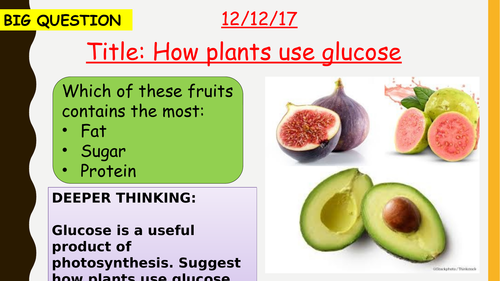


How plants use glucose lesson created in accordance to the NEW AQA Specification (9-1). Designed for a higher ability class, although content can be adjusted to suit any ability. Includes powerpoint timers, slide animations, embedded video’s, practice questions, peer assessment worksheet and mini review. *Top paper friendly tip: the information in the ‘How to use glucose’ worksheet can also be found in the textbook therefore isn’t required to be printed.* NB: If you are unable to play embedded videos please view slide notes for link.
AQA spec link: 4.4.1.3
Relevant chapter: B8 Photosynthesis. AQA Biology third edition textbook-Page 128-129
Students are required to know the following;
The glucose produced in photosynthesis may be:
•• used for respiration
•• converted into insoluble starch for storage
•• used to produce fat or oil for storage
•• used to produce cellulose, which strengthens the cell wall
•• used to produce amino acids for protein synthesis.
To produce proteins, plants also use nitrate ions that are absorbed from
the soil.
AT 8-Tests to identify starch, glucose and proteins using simple qualitative reagents
Get this resource as part of a bundle and save up to 17%
A bundle is a package of resources grouped together to teach a particular topic, or a series of lessons, in one place.
Something went wrong, please try again later.
This resource is OK. They have decided not to do the starch practical, but to show a video of the practical. The main task is making a mind-map. I've actually ended up changing most of it.
Really liked the resource! The PowerPoint was attractive and interactive. Felt there could have been more following the video at the start of the lesson about testing a leaf for starch but generally really good.
Report this resourceto let us know if it violates our terms and conditions.
Our customer service team will review your report and will be in touch.
